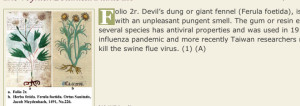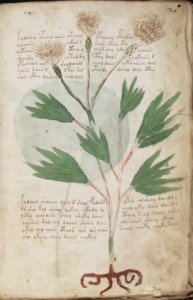Folio 2r features a large plant drawing occupying most of the page from the bottom edge almost to the top, and from almost the right side nearly to the left text margin.
There are two text blocks. The top is broken across the three stems the branch to flower heads. The bottom is broken across a branching stalk.
Most of the stake is painted green and brick red, with the red occuping most of the stem area with the exception of the base of the plant. The top stems that branch to the flower heads are painted red and green.
The leaves are narrowly elliptical or lanceolate and overlap somewhat. Whether they are illustrated as somewhat flattened (as in a herbarium sample) or simply as being behind each other from the point of view of the illustrator is not entirely clear. The leaves are painted a fairly even green and are not serrated. The central group of leaves looks like it may have parallel veins, but the veins are only clear on this group, not on the others.
The flower heads have a scaly look to them, illustrated with red and green dots. It could simply be dots on the calyx, but the one on the right also has underlying lines that indicate a scaly texture such as is common on many thistles and asters. The petals are numerous, fuzzy, and have been painted in with a very light reddish color. Perhaps the illustrator was trying to achieve pink by watering down the brick red or maybe was shading it to resemble an off-white. The pigment on the leaves appears to be applied with a somewhat coarse brush that can’t quite fit into the tiny tips. All the VM plants seem to represent a certain haste or impatience with painting. The penned parts show far more patience and attention to detail. It appears the illustrator may have been more comfortable with pens than brushes, assuming the plants, text, and maps were drawn by the same person.
The scaly calyxes are somewhat narrow and vase-shaped and small in relation to the feathery layers of blossoms or seed fuzz.
Prior Identifications
 Edith Sherwood has identified VM 2r as Ferula foetida (devil’s dung) but F. foetida has umbellate flowers and feathery leaves that are more frondlike than Plant 2r. F. foetida also lacks the “scaly” calyx and feathery petals illustrated in the VM plant.
Edith Sherwood has identified VM 2r as Ferula foetida (devil’s dung) but F. foetida has umbellate flowers and feathery leaves that are more frondlike than Plant 2r. F. foetida also lacks the “scaly” calyx and feathery petals illustrated in the VM plant.
I doubt whether VM 24 is Ferula. I think it’s far more likely that VM 2r is a species of Centauria (e.g., knapweed) or other member of the Aster family. It’s probably not burdock (Arctium), which has a thicker, more rounded calyx.
Not all Centaurea have the alternating appearance on the calyx—on some, the little “scales” (known as phyllaries or bracts) are sometimes tipped or outlined in a darker color rather than alternating in color and some are so profusely hairy that the bracts are almost hidden. C. artgentea has a more alternated calyx, due to the fuller thicker brown tips, but the leaves are rounded and more deeply lobed (and pale green in color) and not a good match for VM 2r.
Brown knapweed (Centaurea jacea) might be a possibility. It has bracts with a somewhat alternating appearance, feathery pink petals and stamens, a scaly calyx that varies between a reddish-brown and pale green, and leaves that resemble clumps when the samples are flattened and dried. Centaurea nigra has many similar characteristics and could also be considered (C. jacea and C. nigra are so closely related that they can interbreed).
Many of the Centaurea have stiff woody root systems, although most tend to be taproots rather than the horizontal curved shapes illustrated in VM 2r. One wonders if the column-like representation of the roots is intended to show spreading curling roots or is symbolic in some way. There are some Cirsiums with spreading roots similar to 2r but they tend to have leaves that are spiny or toothed.
I think there is a much higher probability that Plant 2r is a species of aster, possibly one of the Centauria that has a narrow calyx, rather than a species of Ferula. Centauria is a widespread plant often mentioned as a medicinal herb and sometimes used as animal fodder.
Posted by J.K. Petersen

